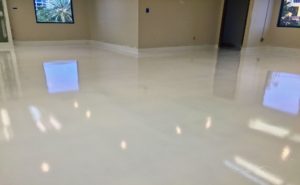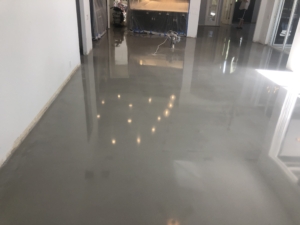In the realm of floor coatings, the polyaspartic vs epoxy discourse is more than a mere debate; it’s a quest for excellence that professionals and industries embark upon. The crux of this deliberation centers around finding a durable and efficient solution for various flooring needs, be it concrete garage flooring or an industrial surface. The epoxy coating has long been a go-to choice, offering a blend of durability and aesthetics. It thrives well on a garage floor, making epoxy garage floor coating a conventional choice for many. However, a new player, polyaspartic coating, has entered the scene, challenging the epoxy’s dominion with its quick curing time and UV resistance.
The epoxy and polyaspartic floor coatings each bring a set of advantages to the table. The former is known for its adhesive prowess and its rapid curing even in cold temperatures.
As we dive deeper, the nuances of epoxy and polyaspartic coatings are unveiled, shedding light on how they interact with concrete flooring, their resistance to chemical compounds, and their behavior under prolonged exposure to UV rays.
The choice between epoxy and polyaspartic coatings is not merely a matter of preference but a calculated decision that can significantly impact the longevity and aesthetics of your flooring project.
In the realm of floor coatings, particularly for garage floors and industrial settings, the “polyaspartic vs epoxy” debate is prevalent. Both coatings offer a protective and aesthetic appeal to surfaces such as concrete floors. However, their compositions and applications have distinct differences worth noting.
A. Epoxy Coating

- Composition and Properties: Epoxy coatings are derived from epoxy resin, a thermosetting polymer known for its strong adhesive properties and resistance to chemical compounds. When applied as a floor coating, epoxy creates a robust, smooth, and durable surface that withstands foot and vehicle traffic, making it a popular choice for garage floor coatings and industrial flooring. One of the notable components in the epoxy coating is its ability to bond well with concrete surfaces, filling in the porous surface and creating a smooth finish.
- Application: The application process of an epoxy coating requires a clean, dry, and slightly porous surface to adhere properly. Surface preparation, including cleaning and possibly etching of the concrete floor, is crucial for the adhesion and longevity of the epoxy floor coating. Following the manufacturer’s instructions regarding the mixing and curing times is imperative. Epoxy coatings need a proper ventilation system during application due to the release of volatile organic compounds (VOCs).
B. Polyaspartic Coatings
- Composition and Properties: Polyaspartic coatings are a type of polyurea, a subgroup of polyurethane. They possess quick curing times and high tolerance to a wide range of temperatures, unlike epoxy takes longer to cure, especially in cool temperatures. These coatings are known for their UV stability, preventing discoloration and degradation under UV exposure, which is a common issue with epoxy when exposed to direct sunlight over time.
- Application: Polyaspartic coatings also require proper surface preparation but boast a faster curing time, allowing for quicker project turnaround. Their fast-curing nature necessitates a swift application process to prevent the coating from hardening before it’s evenly spread. They have a short pot life, which underscores the need for a timely application, yet their ability to bond with concrete surfaces and provide a durable, resistant surface makes them a compelling choice for many flooring situations. The distinct characteristics between polyaspartic and epoxy coatings are pivotal in guiding professionals toward making an informed decision for their specific project requirements.
Comparative Analysis: Polyaspartic vs Epoxy
A. Durability
- Long-term Performance When it comes to long-term performance, both polyaspartic and epoxy floors offer a high level of durability. However, the durability epoxy can sometimes be compromised in environments exposed to UV radiation. Unlike epoxy, polyaspartic coatings do not yellow or fade under UV exposure, maintaining their aesthetic appeal over time. This makes polyaspartic coatings a compelling choice for areas where maintaining the floor’s appearance is crucial, alongside durability.
- Resistance to Chemicals, Abrasion, and UV Rays: Both coatings are known for their chemical-resistant nature, making them ideal for industrial settings or garage floors where contact with corrosive chemicals or substances like brake fluid and oil spills is common. However, polyaspartic coatings offer superior UV resistance, unlike epoxy, which can discolor or chalk with prolonged exposure to direct sunlight.
B. Application Procedures
- Preparation Needed Proper surface preparation is crucial for both polyaspartic and epoxy coatings to ensure optimal adhesion to the concrete surface. This includes cleaning and possibly grinding the concrete floor to create a suitable profile for the coating.
- Curing Time: One significant advantage of polyaspartic coatings is their rapid curing time. Polyaspartic coatings can cure in a matter of hours, unlike epoxy, which can take several days to completely cure, especially in freezing temperatures. This quick curing time means less downtime for businesses, making polyaspartic a favorable choice for projects with tight timelines.
C. Cost Analysis

- Initial Cost The initial cost per square foot for epoxy flooring tends to be lower than that of polyaspartic coatings. Epoxy might range from $3 to $12 per square foot, while polyaspartic costs between $5 to $15 per square foot, making epoxy a more budget-friendly option upfront.
- Maintenance Costs Over Time: Over time, maintenance costs may accrue more with epoxy, especially if it’s exposed to UV rays or harsh chemicals that may require re-coating. On the other hand, the durability and UV stability of polyaspartic coatings can lead to lower maintenance costs.
D. Environmental Impact
- VOC Emissions: Volatile Organic Compounds (VOCs) are a concern for both personal and environmental health. Epoxy products may contain higher levels of VOCs compared to polyaspartic coatings, which can be formulated with low to zero VOCs, making polyaspartic a more environmentally friendly option.
- Eco-friendly Disposal: Disposal of leftover coatings needs to be handled responsibly to avoid environmental contamination. While both coatings require proper disposal, the lower VOC content in polyaspartic coatings may pose less risk to air quality. The comparative analysis between polyaspartic vs epoxy provides a clear view of the advantages and considerations associated with each coating type. While epoxy may be a cost-effective solution initially, polyaspartic coatings offer faster curing times, better UV resistance, and potentially lower long-term maintenance costs.The choice between the two would be determined by the project’s specific needs, the budget, and the environmental considerations of the target audience.
Comparative Analysis: Polyaspartic vs Epoxy
A. Industrial Applications
- Flooring Solutions: Polyaspartic vs epoxy coatings offer distinct advantages for flooring in commercial settings. Epoxy flooring is known for its durability and can handle heavy foot traffic, making it a popular choice for factories and warehouses. A properly applied epoxy floor coating can last for many years, providing a substantial return on the initial investment, which ranges from $3 to $12 per square foot.
- Machinery and Equipment Coating: Protecting machinery and equipment from corrosion and wear is critical in maintaining operational efficiency. Epoxy coating provides a robust protective layer that shields against daily wear and tear, while a polyaspartic floor coating ensures minimal downtime during application with its quick curing time.
B. Automotive Applications
- Workshop Flooring: The garage floor is subjected to oil spills, chemical spills, and heavy loads. An epoxy garage floor coating is resistant to these challenges, providing a clean, safe, and durable surface for automotive workshops. A polyaspartic coating, on the other hand, offers a faster curing solution, making it a go-to choice for busy workshops where time is of the essence.
- Vehicle Coatings: For vehicle owners or automotive shops interested in preserving vehicles’ aesthetics and functionality, polyaspartic and epoxy coatings offer solutions. Epoxy’s resistance to chemicals makes it a reliable choice, while the UV resistance of a polyaspartic floor coating helps maintain the gloss and color of the coated surfaces.
C. Professional Contracting
- Residential and Commercial Flooring: For contractors engaged in residential or commercial projects, understanding the comparative benefits of polyaspartic vs epoxy coatings is crucial. Epoxy floor coatings offer a cost-effective solution with a wide range of design options, including decorative flakes or chips. Polyaspartic floor coatings, however, provide a quicker curing solution, allowing for faster project turnaround.
- Outdoor vs Indoor Applications: Epoxy coatings are typically more suited for indoor applications due to their lack of sun resistance, unlike polyaspartic coatings, which perform well indoors and outdoors. This distinction is vital for contractors when advising clients on the best floor coating solutions for their specific needs.
Engage Professional Guidance in Navigating this Floor Coatings

In wrapping up, we’ve delved into the nuanced comparison between polyaspartic and epoxy coatings, shedding light on their respective merits and potential drawbacks.
The choice between polyaspartic vs epoxy coatings is not merely a matter of preference but a strategic decision that could significantly impact the longevity and functionality of your garage floor or other concrete surfaces.
We underscore the importance of aligning your choice of floor coating with the specific demands of your project. Whether it’s the rapid curing advantage of a polyaspartic garage floor or the cost-effectiveness and proven durability of epoxy garage floors, your decision should hinge on long-term benefits and the operational prerequisites of your environment.
A noteworthy mention is Creative Resurfacing Solutions, a beacon of professional expertise in the realm of floor coatings. Engaging with seasoned experts like them can demystify the complex dynamics between polyaspartic and epoxy, ensuring your venture is anchored on a well-informed foundation.
Your investment in professional installation and consultation today could safeguard your project against unforeseen expenditures and structural pitfalls tomorrow.
Your flooring is not merely a surface but a long-term asset; make your coating decision count.

